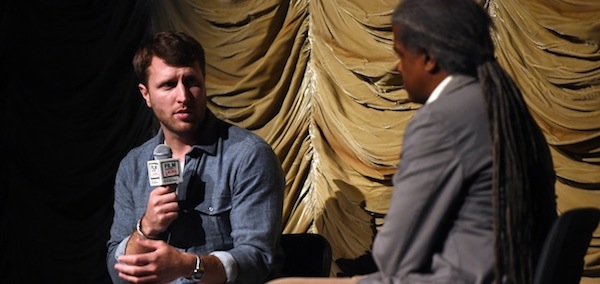Shooting A Meth Lab With Cartel Land’s Matthew Heineman
Matthew Heineman was facing a dilemma. It was fall of 2014 and the Escape Fire director was sitting on a goldmine of material for his new documentary Cartel Land. With just weeks left before the Sundance Film Festival submission deadline, and with more than five hundred hours of footage to sort through, Heineman could either wait for a later festival—or embark on what he called a “crazy experiment” and hire a team of editors to cut around the clock.
Those who saw Cartel Land last Thursday at Film Independent at LACMA know Heineman’s not one to shy way from a challenging situation. “So we had three editors come on board. And I cut myself a little bit,” said Heineman who was also a his own cinematographer. “We all kind of left our egos at the door, divided and conquered.”
And how did they keep all of those creative voices on the same page under such tight time constraints? According to Heineman, a mantra. “The mantra every day,” said the director, “was ‘let’s let the audience go on the same journey I went on.’”
And what a journey it was.
Cartel Land tells the story of two vigilante groups on either side of the US-Mexico border who declare war on the Mexican drug cartels. Heineman sits shotgun for all of the action. In one moment, he’s too busy dodging gunfire to adjust the iris on the camera. In the next, he’s in the back of a van next to a gunman with a captive in a headlock. In still another scene, a young woman looks directly into the camera and talks about the experience of seeing family members brutally murdered in front of her.

Film Independent Curator Elvis Mitchell, who moderated the Q&A that followed Thursday’s screening, described the film as combining “the density of real journalism” with “the momentum of a thriller.”
Heineman said his goal from the beginning was to fully immerse himself in his subject, even if—and maybe especially if—that meant putting himself in danger.
“I really didn’t want to come into this film and put a nice, neat little box around the characters,” he said. “I think it’s really hard to talk about them unless you’ve experienced what they’re going through. And that’s what I wanted to do… I wanted to take this issue out of the headlines and put myself right in the center of what’s happening.”
Heineman continued: “Every day you open a paper in Mexico there’s horrific photos. I really wanted to…see how this was affecting everyday people. And the response of everyday people to rise up and fight back.”
Heineman’s other major goal was more specific—and even more of a challenge.
“I’d always wanted to shoot in a meth lab,” said Heineman to laughter from the crowd. “Is that funny?”
For Heineman, it was a crucial part of the story: “Most of the meth we consume here in the US comes from Mexico. Most of that, from Michoacán [the Mexican state in which much of Cartel Land takes place]. It was an incredibly important part of the story, and every shoot I would ask someone, ‘Hey, do you know somebody who knows somebody who knows somebody?’ We invested so much time trying to get into a lab, and I gave up on it after four or five months because I didn’t think it was going to happen.”
But then he got the call.
“It was on one of our last shoots, one of those days where nothing was going right. Our car broke down up in the mountains in a really dangerous area. Then we got a call saying, ‘Be in this town square at 6:00 pm and you’re in. We drove to the town square and a group of masked men drove us through towns and smaller towns and fields and smaller fields and stopped… Another car drove at us, and they led us into the forest.”
After months of waiting, and all of the protocol of setting up the meeting, (Heineman’s rule was he didn’t want to be thrown in the trunk; the cartel members’ rule was they wanted their faces covered), Heineman had a stomach-turning realization.
“I had dreamed of shooting this scene for so long. I’ve never seen Breaking Bad, but I’d certainly envisioned this halogen-lit trailer,” he said. “And I get out there and it’s this dense forest with the sun down. And I don’t shoot with lights.”
So in that black night, Heineman did what good documentarians do: he watched and waited.
“And the head chef starts showing me around the process of cooking meth with his little flashlight. And it’s with that flashlight that I lit the scene.”
Heineman didn’t say why the cartel finally relented and let him film them cooking meth, which became the opening sequence of the movie. But he said he thought a lot of the access he was granted stemmed from shared conviction with his subjects.
“They were risking their lives to fight for what they believe in, and they were dying, some of them, to do so. And I was tagging along with them. So I think there was a level of respect from the good guys and the bad guys—with quotes—that I was there documenting this story, documenting what was really happening.”
Cartel Land is now playing in select cities. Check here to find a screening near you.
Tom Sveen / Film Independent Blogger